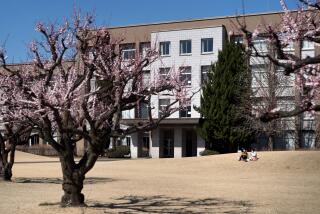Education’s pendulum: Thinkers or test takers?
- Share via
The people of a large and mighty nation wonder why their schools can’t do more to imitate those of another large, powerful nation across the Pacific Ocean. But this time it’s not the United States seeking to emulate the schools of an Asian country — it’s China seeking to emulate ours, at least to some extent.
China is pushing for more emphasis on building creative skills and less on high-stress, high-stakes testing, according to a recent article in the New York Times. Under the existing system, a single entrance exam determines whether students attend college, and which one. Talk about teaching to the test: The last year of high school is often given over to cramming for the exam. In at least one classroom, students were placed on intravenous drips of amino acids in preparation for the test, in the belief that it would help their memories and provide an energy boost; in another sad case, a girl was not told about her father’s death for two months to avoid disrupting her studies.
The recent backlash against the tests includes complaints that students are being fed facts by rote rather than being taught to think critically and create. Two years ago, Premier Wen Jiabao lamented the failure of Chinese schools to turn out innovative thinkers with strong analytical skills. “We must encourage students to think independently, freely express themselves, get them to believe in themselves, protect and stimulate their imagination and creativity,” he said. He even quoted Albert Einstein’s famous line about imagination being more important than knowledge.
DATABASE: California schools guide
This isn’t the first time that a nation with a top-ranked education system has sought to reproduce some of the qualities that have long marked American schools. Ten years ago, Japan embarked on a series of major reforms to reduce stress, de-emphasize memorization and foster more creative thinking. It shortened the school calendar (from six days a week to five) and adopted curricula that encouraged children to create their own projects. More control was placed in local hands, a move away from centralized authority. A few years earlier, Singapore took similar steps.
The reason these nations are concerned isn’t just that they want their students to feel fulfilled and happy. The ability to innovate, and to analyze and solve problems, is seen worldwide as crucial for adapting to the fast-changing global economy. But it is all part of a long-standing tension between the need for academic rigor and the need to foster creativity.
The pendulum swing between the two has been particularly wide in the United States. During the 1990s, Americans lamented the lower academic standards here, especially when compared with nations such as Japan. The sense that American children were falling behind in the developed world — bolstered by international test results in which the United States ranked as mediocre, and given a sense of urgency by the numbers of disadvantaged and minority students who were leaving school without even basic skills — resulted in the 2001 passage of the No Child Left Behind Act, with its heavy emphasis on standardized tests and rigid benchmarks of progress.
Now, even though academic performance among U.S. students is still lagging, many parents and educators are complaining that the push toward a standard curriculum and standardized tests is bleeding lessons of liveliness, and that schools do too little to foster creativity and analytical thinking. They’re not entirely wrong. In keeping with the tests, which are mostly multiple choice, schools have assigned less writing and project work. Teachers have tried to make sure they go over every speck of material that might be on the tests, and because the approved curriculum tends toward the broad and shallow, there’s a lot of short-answer information to cover but not much depth to explore.
Aiming higher on academics shouldn’t have to mean leaving deeper or more open-ended thinking skills behind. No one in the American school reform movement ever told teachers they had to abandon their own creative instructional skills or drop critical-thinking lessons from the school day, but the relentless emphasis on covering tested material obviously pushed them in that direction.
The switch over the next few years in many states, including California, to the so-called common core standards, which emphasize learning fewer things in greater depth, should help somewhat but still falls short. State and federal officials endlessly debate the role of test scores in teacher evaluations, but they pay too little attention to enabling teachers and students to take academic risks — considered essential to building creativity — while ensuring that vital academic material is still covered. It’s not easy to figure out how schools can balance creativity with academic rigor, productive thinking with knowledge. The nations that do so will have the competitive edge in the future.
More to Read
Sign up for Essential California
The most important California stories and recommendations in your inbox every morning.
You may occasionally receive promotional content from the Los Angeles Times.













